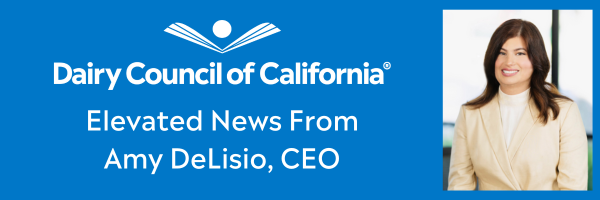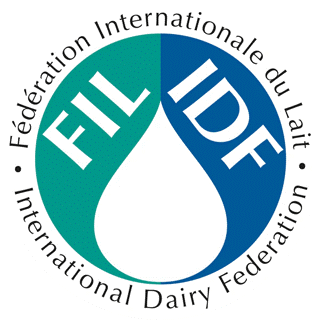
Dear Friend,
This edition of Elevated News includes relevant and timely updates for the dairy community that include both challenges and opportunities in the current environment. We continue to recognize the collaboration, resilience and innovation of the dairy community as we collectively work to amplify dairy’s commitment to healthy, sustainable food systems.
CDFA Updates on Avian Influenza
 The California Department of Food and Agriculture (CDFA) announced that highly pathogenic avian influenza, also known as HPAI, has been confirmed in three California dairy herds. The affected farms in the Central Valley have been quarantined under
the authority of CDFA’s state veterinarian, and enhanced biosecurity measures are in place. The safety of milk and dairy foods has been reaffirmed, as shared in CDFA’s recent news release:
The California Department of Food and Agriculture (CDFA) announced that highly pathogenic avian influenza, also known as HPAI, has been confirmed in three California dairy herds. The affected farms in the Central Valley have been quarantined under
the authority of CDFA’s state veterinarian, and enhanced biosecurity measures are in place. The safety of milk and dairy foods has been reaffirmed, as shared in CDFA’s recent news release:
This evolving situation may impact some of Dairy Council of California’s programs, and we are collaborating closely with dairy community partners and state agency officials to coordinate our efforts and adhere to updated guidance. As a precaution, all Mobile Dairy Classroom (MDC) locations in the Central Valley will be canceled for the remainder of the week pending further guidance from CDFA. As the situation and response is ongoing, Dairy Council of CA will continue to follow the direction of CDFA and the state veterinarian to remain in compliance. Virtual MDC field trips will be offered when in-person assemblies are not possible.
For the most up-to-date information regarding HPAI in livestock in California, please visit CDFA - AHFSS - AHB - Highly Pathogenic Avian Influenza (HPAI) H5N1 Virus in Livestock.
 Thursday, September 5 from 4:30–5:30 p.m. (or longer as needed)
Thursday, September 5 from 4:30–5:30 p.m. (or longer as needed)
Agenda:
Join Zoom Meeting: https://us02web.zoom.https://us02web.zoom.us/j/81603784468
Meeting ID: 816 0378 4468
Passcode: HPAI2024!
Find your local number: https://us02web.zoom.https://us02web.zoom.us/u/kbArpKzF7Y
As recently shared in AgAlert.com, a public hearing on the state dairy quota implementation plan, or QIP, will be held Sept. 9 beginning at 10 a.m. All California dairy farmers and interested individuals may sign up to testify at the hearing.
Join Zoom Meeting: https://us02web.zoom.https://us02web.zoom.us/j/84248601086
Meeting ID: 842 4860 1086
Passcode: 4^5WBjb*
Join by Telephone: 669-444-9171
Meeting ID: 842 4860 1086
Passcode: 04670783
 The U.S. Food and Drug Administration (FDA) released draft guidance outlining a new set of proposed voluntary sodium reduction goals for the U.S. food and beverage industry (Phase II). The new proposed targets are a follow-up to the FDA’s initial short-term sodium reduction goals finalized in 2021 (Phase I). These goals are intended to bring Americans’ sodium intakes closer to the Dietary Guidelines for Americans recommendation of no more than 2,300 mg sodium per day.
The U.S. Food and Drug Administration (FDA) released draft guidance outlining a new set of proposed voluntary sodium reduction goals for the U.S. food and beverage industry (Phase II). The new proposed targets are a follow-up to the FDA’s initial short-term sodium reduction goals finalized in 2021 (Phase I). These goals are intended to bring Americans’ sodium intakes closer to the Dietary Guidelines for Americans recommendation of no more than 2,300 mg sodium per day.
In addition to the release of the proposed Phase II targets, the FDA also shared a preliminary assessment of progress in meeting the Phase I sodium reduction goals. Here are a few key highlights:
For Phase II, the FDA has proposed making many of the dairy (cheese) sodium targets more restrictive, but it has also proposed making about a third more lenient. More details on the proposed targets can be found in FDA’s Draft Guidance for Industry document.
The FDA’s sodium reduction targets, while voluntary, are influential in informing other policies. By reformulating products to meet the FDA sodium targets, companies can ensure their products also comply with other federal nutrition policies. FDA is accepting comments on the proposed Phase II targets. The dairy community is encouraged to share success, perspectives and insights during the public comment period. All comments should be identified with docket number FDA-2014-D-0055 and submitted by November 14, 2024.
Registration for the next Dietary Guidelines Advisory Committee (DGAC) meeting is now live: 2025 Dietary Guidelines Advisory Committee: Meeting 6. The meeting will be held the following dates and times:
Looking ahead, there will be one final DGAC meeting held October 21–22. During this meeting, the committee will provide an overview and “discuss its findings and advice it plans to include in its scientific report before the report is submitted to HHS and USDA.” It is possible that the 2025 Scientific Report will be released to the public in mid-November.
The Reinforcing Climate Risk Management from Farmers’ Behavior and User-Driven Indicators (FRISBE project) is gathering farmers’ knowledge on climate variability and its effects on crops and livestock. Coordinated by Professor Alvar Escriva-Bou (University of California, Los Angeles) and Professor Sandra Ricart (Polytechnic University of Milan, Italy), the online survey aims to capture farmers’ experiences and expertise on perceived impacts, implemented adaptation measures and identified barriers. The information will be utilized to enhance the understanding of farmers’ perspectives and needs.
Farmers are invited to participate in the FRISBE project through this online survey, which should take no more than 10–12 minutes: https://forms.office.https://forms.office.com/e/yZr0Fzgw1g
Recently Published: Advancing the Dairy Matrix
 We are excited to announce a new publication that exemplifies a remarkable international effort brought together by the International Dairy Federation (IDF). Recently published in the journal Nutrients, “The Dairy Matrix: Its Importance, Definition, and Current Application in the Context of Nutrition and Health" reinforces these important concepts:
We are excited to announce a new publication that exemplifies a remarkable international effort brought together by the International Dairy Federation (IDF). Recently published in the journal Nutrients, “The Dairy Matrix: Its Importance, Definition, and Current Application in the Context of Nutrition and Health" reinforces these important concepts:
Congratulations to IDF and the team of international dairy nutrition experts, including Dairy Council of CA Officer of Nutrition & Industry Affairs Ashley Rosales, for this timely publication.
If you have questions, concerns or feedback you would like to share, please do not hesitate to reach out.
Best regards,
Amy DeLisio, CEO
Dairy Council of California
adelisio@DairyCouncilofCA.org